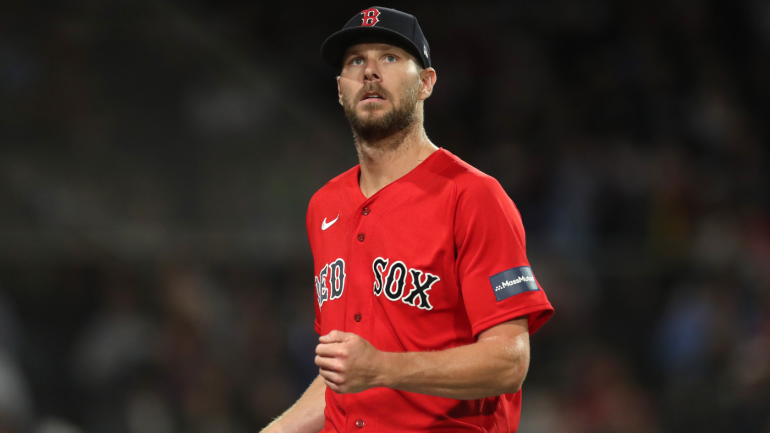
The Atlanta Braves closed out 2023 with a surprising move, obtaining left-handed starter Chris Sale from the Boston Red Sox on Saturday in exchange for infielder Vaughn Grissom. (You can read our full analysis of the trade here.) The Red Sox included $17 million to facilitate the trade. The Braves, then, will pay Sale only $10.5 million during the 2024 season.
Sale, a seven-time All Star, is expected to slot into Atlanta's rotation alongside Spencer Strider, Max Fried, and Charlie Morton. Last season, he made his greatest number of starts (20) since the 2019 campaign. Sale compiled a 4.30 ERA (106 ERA+) and a 4.31 strikeout-to-walk ratio across those outings, resulting in an estimated 1.7 Wins Above Replacement, per Baseball-Reference.
You might question the wisdom of the Braves, a team whose October was cut short by ill-timed injuries, adding another starter with durability concerns. (Sale has appeared 31 times since the end of the 2019 season.) You might also wonder if Sale still has what it takes to be a meaningful contributor on a good staff. We can't say for sure on the first part -- player health remains a great unknown for public analysis -- but we feel confident about the latter half.
To wit, below CBS Sports has highlighted three statistics that illustrate why the Braves should win their bet on Sale being an above-average starter in 2024.
1. Average exit velocity
As we noted in our initial trade analysis, teams these days tend to prioritize two traits above all when analyzing pitchers. The first is contact management.
Chris Sale, Filth. 😷
— Rob Friedman (@PitchingNinja) May 13, 2023
7th, 8th and 9th Ks. pic.twitter.com/qKgCaR0tlu
At the risk of stating the obvious, teams prefer their pitchers not give up loud contact on a consistent basis. There are exceptions who make it work -- Zac Gallen and Framber Valdez had two of the highest average exit velocities against among starters in 2023 and that didn't prevent them from having good seasons. But, for the most part, those on the bottom of the leaderboard tend to suffer from a deficiency, be it in the form of their stuff and/or location.
| Split | Avg EV | 95+ mph% |
|---|---|---|
Sale | 87.3 mph | 34.7% |
League average | 88.8 mph | 40.1% |
The Braves can rest easy without any such concerns. Sale remains skilled at suppressing the opposition's quality of contact. Indeed, his average exit velocity ranked 26th among pitchers who started at least 10 times in 2023. That places him just behind reigning National League Cy Young Award winner Blake Snell and just ahead of Eduardo Rodríguez, whom the Arizona Diamondbacks were so taken with as to sign him to a four-year pact worth $80 million.
Additionally, less than 35% of the batted balls Sale surrendered had an exit velocity of 95 mph or higher. That's a lower percentage than Shohei Ohtani, Strider, Max Scherzer, and Zack Wheeler. Good company to keep.
2. Whiff and chase rates
The other trait that teams place an emphasis on nowadays is missing bats. The logic is straightforward: a pitcher capable of reliably generating whiffs likely has some kind of plus component to their game, be it in the form of pure stuff, location, deception, or a combination of the three variables.
Chris Sale's 3 1st Inning Ks. pic.twitter.com/uxwkGZ8ZBM
— Rob Friedman (@PitchingNinja) June 1, 2023
Here's a look at Sale's arsenal by various metrics:
| Pitch type | Whiff% | In-zone whiff% | Chase% |
|---|---|---|---|
Fastball | 24% | 18.1% | 31.4% |
Slider | 39.4% | 25.3% | 36.8% |
Changeup | 31.5% | 27.5% | 34.9% |
It bodes well for the Braves that Sale ranks highly across the board. His 29.7 whiff rate was tied with Kodai Senga for 20th best among starters. His in-zone contact rate -- a fancy way of seeing if a pitcher is capable of overmatching batters within the confines of the strike zone -- ranked 24th. Sale also had the eighth-best chase rate among starters, indicating that he's capable, too, of enticing batters to expand their zones in pursuit of his pitches.
3. Strike rate
While teams are taken by pitchers who can miss barrels and bats alike, we'd be remiss to ignore the importance of a starting pitcher's control. You have to throw a baseline amount of strikes for the other stuff to matter. Luckily for the Braves, this is yet another area where Sale possesses above-average traits.
Chris Sale, Shoving. 🔥 pic.twitter.com/UUudczMw2J
— Rob Friedman (@PitchingNinja) May 5, 2023
More than 65% of Sale's pitches last season went for strikes, putting him above the 64.3% league-average line for starters. This shouldn't come as a surprise. After all, Sale hasn't issued more than 2.5 walks per nine innings since 2011. It's safe to write you're doing some things right mechanically if you're able to keep your walk rate that low for more than a dozen years.
Add it all together, and you have the portrait of a talented pitcher. Sale can still throw strikes, miss bats, and induce weak contact at rates that make him above-average in each of those respects. Sure, Sale may not be able to regain his old elite form, when he received Cy Young Award consideration seven years running. Provided he can stay healthy -- no given, mind you -- there's ample reason to think he's going to be a productive member of the Braves rotation.


















